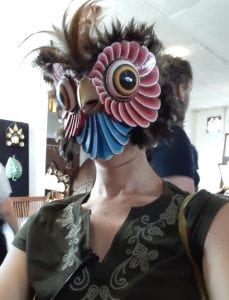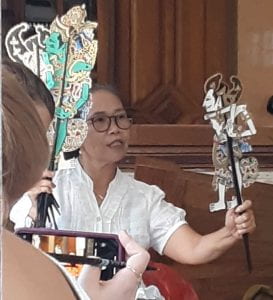During the last few days in Bali before leaving for Java, the SIT group spent a day or two visiting the workshops of traditional artists: a Topeng (mask-making) maker, a Wayang (shadow puppetry) artist and performer, and a traditional Balinese dancer. Something the Topeng artist highlighted in his lecture kickstarted my awareness of the connections between my experiences in Indonesia and those in the United States. He spoke about his experiences as a youth before he became fully involved in Topeng-making for Indonesian dance. Specifically, he stated that he had to learn how to dance before he could even attempt to craft an appropriate mask for dancing. He mentioned a couple other artistic mediums that he dipped his toes into before Topeng, but by then I had already made my connection. The philosophy that his speech implied echoed my own understanding of Whitman’s principles as a liberal arts institution. From my time at Whitman, I have noticed an effort on the part of the faculty to cultivate cross-disciplinal knowledge and study. The more information about other disciplines that students possess, the better equipped they will be to tackle a single subject or discipline holistically.
And I’ve learned that implementing a cross-disciplinal approach can also be fruitful across borders. In Indonesia, as an English major I assumed that I would not use many of my skills learned at Whitman in a program focused on art, religion, and social change. When I was researching study abroad programs, this SIT program was not one recommended for English majors, and I have taken that to heart. However, I’ve found my English major incredibly useful while here, especially when it comes to learning the language (Bahasa Indonesia). My ease may be due to my basic understanding of grammar and my versatility in figuring out how to convey something in multiple different ways—because my vocabulary in Bahasa Indonesia is limited and I constantly need to creatively construct simple sentences that work around my limitation. I also use my English major and general interpretive analytical skills learned at Whitman to conduct analysis on the lectures that we have to attend in SIT. I imagine that my English major will only aid me further during the Independent Study Project (ISP) period, during which I will need to think critically about what questions to pose during interviews, when I will need to declare my data collection sufficient enough to construct a paper, and when I need to actually write said paper. I feel my English major at work together with my many interests in Indonesia, and it is a glorious communion.
On the subject of building bridges between fields of academia, I want to speak a little bit about this SIT program’s methodology to learning. It has become very clear to me that we begin the day with a lecture and some reading about some subject, for example some components of Buddhist Indonesia, then we visit some significant places in relation to that topic, such as a Buddhist temple named Borobudur. We take such trips often for the purpose of contextualizing the lectures, and I must say that I deeply appreciate this approach to learning. This methodology helps me merge my intellectual knowledge with the material world, which in turn reinforces the reality of that knowledge and its relevancy within everyday Indonesian life. I find this approach overall quite effective in supporting the program’s goals to effectively impart cultural knowledge about Indonesia, to integrate its students into the culture, and to prepare us to conduct a participant observation field study while at the same time we seek out written articles for our research.
Thank you, and until next time!




